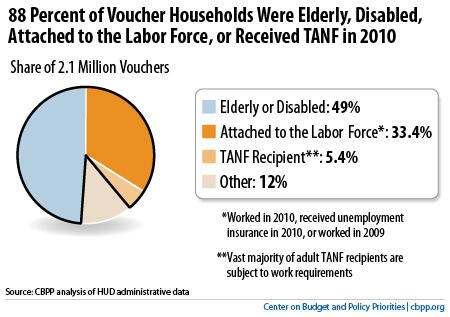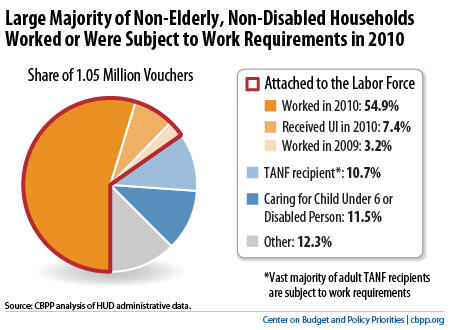BEYOND THE NUMBERS
In hearings on the Section 8 Savings Act, which would make a number of changes to the Housing Choice Voucher program (see our testimony), some policymakers expressed interest in increasing self-sufficiency among recipients of housing assistance.
While that is a worthy goal, our detailed new report on the demographic characteristics and labor force attachment of voucher households found that the large majority of households that can reasonably be expected to work, do work.
Specifically, in 2010, 88 percent of all voucher households were:
- elderly,
- disabled,
- working (or had recently worked), or
- receiving assistance through the Temporary Assistance for Needy Families (TANF) program and thus likely subject to work requirements (see first chart).

Concerns about work effort among recipients of housing assistance typically focus on families that are not elderly or disabled. The second chart takes a closer look at these families, who make up slightly more than half of all voucher households.
About three-fourths of non-elderly, non-disabled voucher households are attached to the labor force — that is, they worked in 2010 or 2009 or likely were required to look for or prepare for work as part of their participation in TANF. The typical income for a family that worked in 2010 was about $17,000 — not enough to enable a family to afford decent housing in most places.

Nearly half of the non-elderly, non-disabled households that weren’t attached to the labor force included a pre-school child or a person who has a disability (other than the head of the house or spouse). Caring for these individuals may make it difficult or impossible for single heads of households to work without child care subsidies or other assistance.
That leaves about 129,000 voucher households that aren’t disabled or elderly, don’t work, aren’t subject to work requirements, and don’t include a young child or person with a disability. These households tend to receive assistance for a shorter time than other voucher households, and they are spread out among several thousand local public housing agencies across the country — most of which don’t serve enough such households to justify the staff time required for a work-related intervention.
Policymakers should consider these facts when considering changes to the voucher program.
